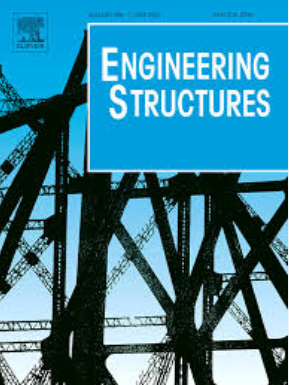冷弯型钢夹紧薄板剪力墙螺纹连接抗剪性能试验研究
IF 5.6
1区 工程技术
Q1 ENGINEERING, CIVIL
引用次数: 0
摘要
本文对冷弯型钢夹紧薄钢板剪力墙(CFS-CTSPSW)的抗剪性能进行了试验研究,采用端柱夹紧的方式增强薄钢板的约束。首先,对4个自攻螺纹连接试件进行单调和循环加载。结果表明:循环荷载对薄钢板造成渐进式损伤,螺纹连接的承载能力降低;此外,还对4台全尺寸cfs - ctspsw进行了准静态加载试验。对cfs - ctspsw的损伤特性、迟滞曲线、骨架曲线、耗能能力、强度退化和刚度退化进行了评价。结果表明:与纯钢框架相比,夹紧钢板提高了剪力墙的完整性,在荷载作用下形成了拉伸带,初始刚度提高4.93倍,极限承载能力提高1.75倍,耗能性能提高70 %;刚性条与薄钢板共同抗水平荷载,峰值抗剪能力提高45% %。然而,刚性条限制了钢框架的水平塑性变形,使钢墙体的延性降低了45% %。最后,对CFS-CTSPSW的设计方法提出了建议和意见。本文章由计算机程序翻译,如有差异,请以英文原文为准。
Experimental study on the shear behavior of cold-formed steel clamped thin steel plate shear walls and screw connections
In this paper, the shear performance of cold-formed steel clamped thin steel plate shear wall (CFS-CTSPSW) was experimentally investigated, utilizing clamped end columns to enhance the confinement of thin steel plates. Firstly, four self-tapping screw connection specimens were subjected to monotonic and cyclic loading. The results indicated that cyclic loading caused progressive damage to the thin steel plates and reduced the load-bearing capacity of the screw connections. Furthermore, quasi-static loading tests were conducted on four full-scale CFS-CTSPSWs. The damage characteristics, hysteresis curves, skeleton curves, energy-dissipation capacity, strength degradation, and stiffness degradation of the CFS-CTSPSWs were evaluated. The results demonstrated that, compared with a pure steel frame, the clamped steel plate improved the integrity of the shear wall and formed tensile bands under load action, thereby increasing the initial stiffness by 4.93 times, ultimate load-bearing capacity by 1.75 times, and energy-dissipation performance by 70 %. The rigid strips resisted horizontal loads along with the thin steel plates, thereby increasing the peak shear capacity by 45 %. However, the rigid strips restricted the horizontal plastic deformation of the steel frame and decreased the ductility by 45 % of the steel walls. Finally, the recommendations and comments on the design methodology of the CFS-CTSPSW s were given.
求助全文
通过发布文献求助,成功后即可免费获取论文全文。
去求助
来源期刊

Engineering Structures
工程技术-工程:土木
CiteScore
10.20
自引率
14.50%
发文量
1385
审稿时长
67 days
期刊介绍:
Engineering Structures provides a forum for a broad blend of scientific and technical papers to reflect the evolving needs of the structural engineering and structural mechanics communities. Particularly welcome are contributions dealing with applications of structural engineering and mechanics principles in all areas of technology. The journal aspires to a broad and integrated coverage of the effects of dynamic loadings and of the modelling techniques whereby the structural response to these loadings may be computed.
The scope of Engineering Structures encompasses, but is not restricted to, the following areas: infrastructure engineering; earthquake engineering; structure-fluid-soil interaction; wind engineering; fire engineering; blast engineering; structural reliability/stability; life assessment/integrity; structural health monitoring; multi-hazard engineering; structural dynamics; optimization; expert systems; experimental modelling; performance-based design; multiscale analysis; value engineering.
Topics of interest include: tall buildings; innovative structures; environmentally responsive structures; bridges; stadiums; commercial and public buildings; transmission towers; television and telecommunication masts; foldable structures; cooling towers; plates and shells; suspension structures; protective structures; smart structures; nuclear reactors; dams; pressure vessels; pipelines; tunnels.
Engineering Structures also publishes review articles, short communications and discussions, book reviews, and a diary on international events related to any aspect of structural engineering.
 求助内容:
求助内容: 应助结果提醒方式:
应助结果提醒方式:


